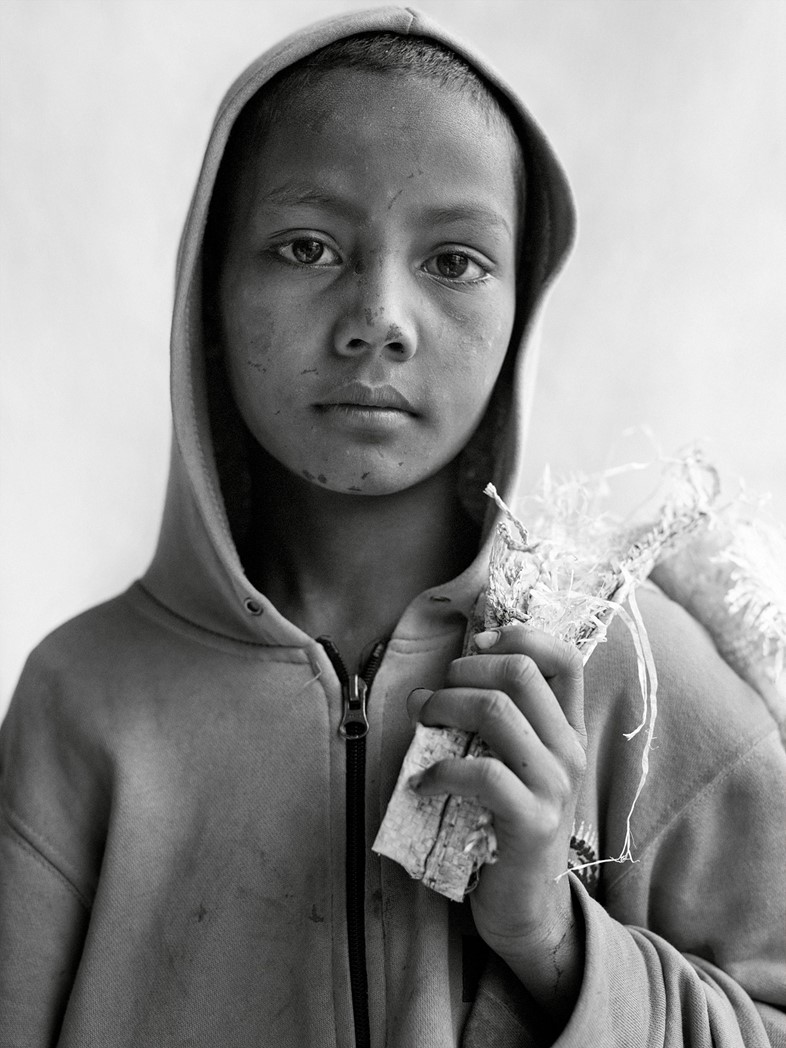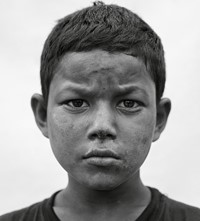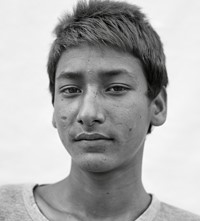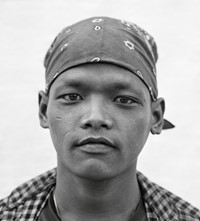Sean Alexander Geraghty speaks to Willy Ndatila about his powerful series shot in Kathmandu
- TextWilly Ndatila
Sean Alexander Geraghty’s portraits of Nepal’s ragpickers and homeless children remind me of Richard Avedon’s ‘American West’ portraits. The blank, seamless background of his makeshift street studio pushes the subject forward in a relentless frontality. There is nothing that might situate or inform their place in the world or society. Sean Alexander Geraghty’s plain white backdrop levels the playing field in a society, which is heavily structured around social casts. In Nepal touching other people’s dirty trash is close to taboo, ragpickers are considered untouchables. The apparent simplicity of these portraits require artistic depth, compassion and social insight. The children are often scorned and mistreated by society and the police force.
Nepal has a population of 5,000 homeless children trying to survive on the streets of Kathmandu. Family violence and economic hardship have pushed them to a life on the streets and joining gangs. The majority are addicted to glue and fall prey to sexual tourism. I fell in love with these portraits because in a small way they give dignity back to those who have been stripped of it – unlike ‘poverty porn’, which is often used in the West as a means to raise funds or bring awareness. In a bid to combat compassion fatigue, poverty porn creates guilt at best and at worst superiority and disconnect in the West, as demonstrated in Trump’s “shithole countries” comment, in reference to African nations. Sean Alexander Geraghty’s portraits show love and respect while dealing with a very difficult subject.
How did you get into photography?
At 19, after school. I started working for photojournalist Nick Danziger, helping him reorganise his archive. It was awesome, basically spending all day looking at amazing black and white prints. Then I went to work for Oliviero Toscani’s ad agency in Italy as assistant photo editor and junior art director. After that, moved to London, assisted freelance (Sean & Seng, Miles Aldridge) and eventually full-time for Boo George for five years. In the end, I really felt it was time for me to move on and do my own pictures.
You went to Nepal to teach underprivileged children boxing, how did the idea of setting up your makeshift studio come about?
After all those years of assisting I needed a break, I had time and money so decided to volunteer for a charity and since I had been boxing for couple of years, I thought it would be cool to train underprivileged kids. I went to Pokhara in Nepal via a local NGO to give sport lessons to orphans. I was amazed by the mix of heritage of the people – basically, Nepal is a tiny country between two giants (India and China) so you have an incredible mix of origins. The idea came to me to do portraits and try to document the population. I built a ‘mobile daylight studio’, Avedon style, with what was available and set up around town and stopped people I found interesting for a portrait. I was always seeing a group of kids picking up things from the bins and sniffing glue, got very curious, they were so young... I followed them, somehow managed to meet the ‘leader’ and eventually became friends with the gang. I took my ‘studio’ to the place where they sell the things they collect on the outskirts of the city and made those pictures.
You made a clear and conscious decision not to photograph the ragpickers during their daily gruelling work. You explained to me you didn’t want to use what I referred to as ‘poverty porn’. A form of a sensationalist type of photography which is often used by charity organisations or news outlets. It is based on the idea that ‘worst is best’, it leverages pity in its attempt to engage with the West. We have that a lot in Africa. It attempts to drive social impact and awareness but what it creates in the West is guilt, pity and superiority which much too often changes into disrespect and disconnect. There is a lot of respect and dignity in each portrait what was your relationship with the Nepalese children you photographed?
Actually, I shot a few pictures of them collecting and sniffing but obviously they were not very comfortable looking and a bit ashamed of it. I really wanted to portray them in a better way and since this is what fashion photography is about, I just thought I would shoot them like models. They actually loved being photographed in ‘the studio’, they would all queue to have their portrait taken, some of them would try to come twice!

I picked up on the hairstyles, earrings worn by the very young ragpickers and you mentioned it was something which was kind of important for the gang members although it contrasts with the hardship and abject poverty of their lived experience. Can you expand on that?
Most of the kids on the streets belong to gangs, it’s a way for them to protect each other’s because on the street they are very vulnerable from abuses of the adults. Also, being ragpickers set you on the margins of society, but interestingly enough they play with that. They have all sorts of codes, from crazy hairstyle to flashy earrings and trendy sportswear. They really want to distinguish themselves and are almost proud of belonging to this group. It’s crazy to say that but they are definitely the coolest kids in town.
You mentioned that 90% of homeless children are addicted to glue, although it causes heart failure or death by asphyxiation, it is their way to fight hunger, the cold nights and eases the pain of being on the streets. The same can be said about the kids on the streets of Johannesburg. Did you see any drug awareness or help for addiction while in Nepal?
The kids in Nepal sniff carpet adhesive glue, it can only be found in certain stores. The craziest thing is that shopkeepers take advantage of it and sell it to the kids for a higher price. Thankfully there are some really good local NGO that take the addicted children into rehab program. The recovery is very difficult and quite often the brain and heart damage are irreversible.
Your next project is based on the Chinese Cuban community you discovered during one of your trips to Cuba. Is travelling a source of inspiration outside your fashion work? How do you approach other cultures, what are your concerns when you photographed other cultures?
Yes, I am currently halfway through the project, it’s called ‘Barrio Chino, Habana’. It’s aimed at documenting the remaining fragments of the once glorious and second biggest Chinatown in the world after San Francisco. I love travelling and discovering new cultures, experience local traditions, I sometimes feel a bit claustrophobic in Europe. Travelling is by far the best way for me to get inspiration and these projects are almost a perfect excuse to get closer to communities. Since every picture is a point a view, a decision, you need to be careful. I am always concerned about the representation of the subject but generally if they are happy with the picture I am happy too!















